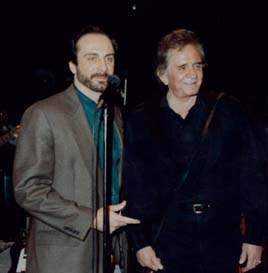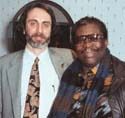Striking a chord in American culture
If Bruce Conforth’s house burst into flame, he would grab one LP from his massive collection: Big Brother & the Holding Company’s self-titled debut. His copy, signed by Janis Joplin, was a gift from the band.
“I never met Janis, which is probably why it means so much to me,” he says.

Conforth welcomes Aretha Franklin to the Rock And Roll Hall of Fame, 1987. (Image courtesy of Bruce Conforth.)
For someone like Conforth, a guy who blames the digital cloud for killing the cultural artifact, the choice is a good one, albeit not easy to make. This musician, author, archivist, and professor has made a career collecting countless items that define pop history. The founding curator at Cleveland’s Rock and Roll Hall of Fame, he now shares his passion for creative expression and live performance with students of American Culture in the College of Literature, Science, and the Arts. In early 2012 those students honored him with the University’s annual Golden Apple Teaching Award.
“I think it’s really important to let students know that whatever subject you are teaching, it is ultimately about them,” he says. “And therefore that subject is important, not as an end in and of itself, but because it will tell them something about themselves and their heritage.”
Tangled up in blues
Conforth’s obsession with the arts, youth movements, and subcultures began when he was a New Jersey teenager trolling Greenwich Village in the early 1960s. The young Beat-wannabe discovered Izzy Young’s Folklore Center. The hipster haven “was a tiny little store—just two rooms.” In front there were instruments, books, and records by artists like Robert Johnson and the New Lost City Ramblers, which offered sweet respite from the bubblegum horrors of Frankie Avalon and Pat Boone.
“And then,” Conforth adds, “Izzy had a little room in the back.” It was there the budding bohemian occasionally caught a glimpse of, and even exchanged a few words in passing with, a 21-year-old Bob Dylan clearly manifesting some manner of poetic brilliance on a borrowed manual typewriter. “I think about that sometimes and wonder, man, what amazing songs could he have been putting down back there?”
Izzy’s shop was tucked amid such MacDougal Street basket houses as the Gaslight Cafe where fans literally “passed the basket” to pay blues performers like Mississippi John Hurt, Skip James, and Son House. It was here that Conforth continued his early education.
“It was like a whole other world,” he says, visibly drifting there in his mind. “To see Son House and actually sit down and talk to him and have him show you stuff on the guitar … “
You’ve got mail
Such intimate exposure to early idols humanized popular artists for Conforth and fueled his fascination with the intersection of person and performance. While editor of his college literary magazine, he had the chutzpah to solicit, receive, and publish original and exclusive work by John Lennon, Allen Ginsberg, and Charles Bukowksi.
“I thought, ‘Why not reach out to some big-name people and see what we get?’ So I found a PO box for Lennon in Astoria Station and, lo and behold, he sent me a poem and his declaration of Nutopia.”
He vividly recalls opening a packet addressed to him by Bukowski, including some 20 poems covered in drawings: “It blew me away. And we kept up communication for quite some time.”
Conforth went on to develop a friendship with the much-older Ginsberg and, years later, would find himself in the late Beatle’s white room at the Dakota, negotiating with Yoko Ono to procure collectibles for display in the Rock and Roll Hall of Fame. “John was physically gone, but still so incredibly present,” he says.

Conforth and Johnny Cash at the 1992 Rock and Roll Hall of Fame Ceremony. (Image courtesy of Bruce Conforth.)
Flat, black, and circular
Having studied popular music in all media, from the scratchy 78 to the pristine digital download, Conforth is a self-described “luddite” who prefers to hold a book—even a CD at this point—in his hands. He celebrates technology’s ability to diversify and globalize emergent subcultures, but he still worries about the extinction of the physical artifact in our mass-commodified, industrialized age.
“Used to be you could walk into somebody’s apartment,” he says, “and you’d be able to see the books, the records, the tchotchkes they have, and you would know, almost instantaneously, everything you need to know about that person.” He cites the prescient folklorist Alan Lomax who once warned that future generations will curse us for destroying valuable evidence that our culture even existed.
But as much as Conforth celebrates the tangible, he cites his array of personal encounters as more significant than any souvenir. Consider the time he waited backstage to meet Ray Charles, “which, to me, was like meeting God.” For 15 or 20 minutes, Conforth listened to Charles riff on a piano in an adjacent room.
“He was playing this beautiful free-form jazz and gospel stuff and it was just—it was just unbelievable, and I almost felt like a voyeur, because this was Ray Charles becoming himself again after having been the on-stage Ray, you know?”
Then there was the time in 1991 when the late Jimi Hendrix was inducted into the Rock and Roll Hall of Fame. As curator, Conforth was entertaining Hendrix’s father, Al, in his suite at New York’s Waldorf-Astoria when he heard a knock on the door.

Conforth and B.B. King, 1991. (Image courtesy of Bruce Conforth.)
“B.B. King was standing there; that alone was pretty amazing,” he says. “B.B. had never met Al, but Al instantly knew who B.B. was. I introduced them, and each man stood back for a second. And then B.B. walked over to Al and gave him this huge hug, and said, in just above a whisper, ‘I want to let you know how much I loved your son.'” Conforth takes a deep breath and sighs. “I get teary thinking about it now. That was a very real moment in both of their lives.”
It’s not only rock and roll
Three years with the politically charged Rock and Roll Hall of Fame took its toll on Conforth’s psyche and he moved on. But not before logging memorable exchanges with the Kinks’ Ray and Dave Davies, the reunited members of Cream, and the troubled Sly Stone to name just a few. These days Conforth uses music as an opening to academic discourse on myth, cultural appropriation, ownership, authenticity, and racism. He is a performer himself who once chased his own record deal and performed with the likes of Dave Van Ronk. He still has a band and often jams with fellow musicians enrolled in his classes. Music is an ideal way to connect with young people, he says.
“A good musician engages you,” he says. “You’re not just blown away by their technique. You’re blown away by the way they’re saying what they’re saying. And I think teaching is exactly the same thing. Great artists draw you into their work. Great teachers should draw you into their subject.”
For his part, Conforth is still drawn to a vast range of subjects that touch American music and folklore. His doctoral thesis was titled “Haight Ashbury: The Rise and Fall of a Modern Folk Community” and his forthcoming book, African-American Folk Songs and American Cultural Politics, explores the early American Left’s attempt to co-opt the African protest song as the soundtrack to a burgeoning communist movement. The book is a complement to two albums of African-American folk recordings Conforth produced from the collection of folk song collector Lawrence Gellert.
American music, American myth
Most recently the writer-historian completed a manuscript he hopes will be “the definitive Robert Johnson biography,” debunking various myths and misconceptions about this quintessential American icon.
“In those days, blues musicians made up their songs by combining lyrics from past iterations,” Conforth says. “Son House never sang the same song the same way twice. But Robert carried a notebook everywhere and wrote down his lyrics. He would sing his songs exactly the same way every single time. This tells you something about his concept of himself as an artist: ‘This is a composition. This is a piece.’
“He was almost like Baudelaire or Rimbaud,” he continues, “like a French surrealist poet. He created word paintings: ‘I gotta keep movin’, I gotta keep movin’. Blues falling down like hail. And the day keeps on worrying me; there’s a hellhound on my trail.’ Who writes lyrics like that? And his guitar playing—it’s almost baffling at times.”
Like most Johnson fans and scholars, Conforth is as intrigued by the myth as the man. Johnson’s mysterious and untimely demise—ensuring his enduring and iconic status—is just another “great American trope” that informs Conforth’s coursework.
“Part of the American Dream, I think, is the idea of ‘promise unfulfilled,'” he says. “Turning people like Robert and Janis and Gershwin into icons is the only way we have of keeping them alive. We’ve become their caretakers and it’s our way of equalizing greatness. In other words, ‘the great’ are actually no greater than we are–because we are the ones who keep them alive.”
It’s a tough job, Conforth admits, reflecting on his life’s work as scholar, teacher, musician, and fan. But, you know, what they say: Somebody’s gotta do it.



